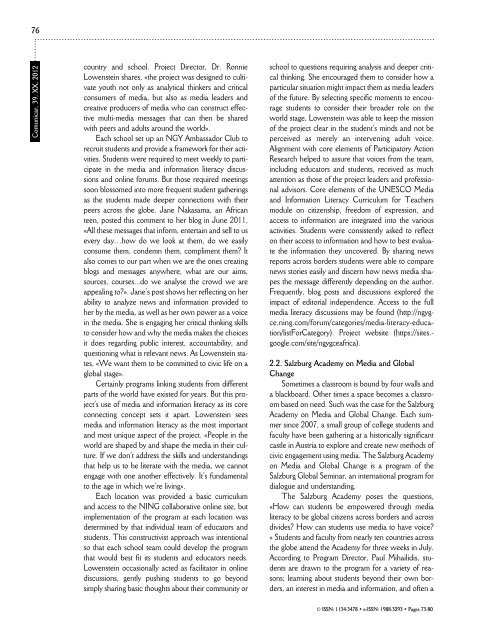Comunicar 39-ingles - Revista Comunicar
Comunicar 39-ingles - Revista Comunicar
Comunicar 39-ingles - Revista Comunicar
You also want an ePaper? Increase the reach of your titles
YUMPU automatically turns print PDFs into web optimized ePapers that Google loves.
76<strong>Comunicar</strong>, <strong>39</strong>, XX, 2012country and school. Project Director, Dr. RonnieLowenstein shares, «the project was designed to cultivateyouth not only as analytical thinkers and criticalconsumers of media, but also as media leaders andcreative producers of media who can construct effectivemulti-media messages that can then be sharedwith peers and adults around the world».Each school set up an NGY Ambassador Club torecruit students and provide a framework for their activities.Students were required to meet weekly to participatein the media and information literacy discussionsand online forums. But those required meetingssoon blossomed into more frequent student gatheringsas the students made deeper connections with theirpeers across the globe. Jane Nakasama, an Africanteen, posted this comment to her blog in June 2011,«All these messages that inform, entertain and sell to usevery day…how do we look at them, do we easilyconsume them, condemn them, compliment them? Italso comes to our part when we are the ones creatingblogs and messages anywhere, what are our aims,sources, courses...do we analyse the crowd we areappealing to?». Jane’s post shows her reflecting on herability to analyze news and information provided toher by the media, as well as her own power as a voicein the media. She is engaging her critical thinking skillsto consider how and why the media makes the choicesit does regarding public interest, accountability, andquestioning what is relevant news. As Lowenstein states,«We want them to be committed to civic life on aglobal stage».Certainly programs linking students from differentparts of the world have existed for years. But this project’suse of media and information literacy as its coreconnecting concept sets it apart. Lowenstein seesmedia and information literacy as the most importantand most unique aspect of the project. «People in theworld are shaped by and shape the media in their culture.If we don’t address the skills and understandingsthat help us to be literate with the media, we cannotengage with one another effectively. It’s fundamentalto the age in which we’re living».Each location was provided a basic curriculumand access to the NING collaborative online site, butimplementation of the program at each location wasdetermined by that individual team of educators andstudents. This constructivist approach was intentionalso that each school team could develop the programthat would best fit its students and educators needs.Lowenstein occasionally acted as facilitator in onlinediscussions, gently pushing students to go beyondsimply sharing basic thoughts about their community orschool to questions requiring analysis and deeper criticalthinking. She encouraged them to consider how aparticular situation might impact them as media leadersof the future. By selecting specific moments to encouragestudents to consider their broader role on theworld stage, Lowenstein was able to keep the missionof the project clear in the student’s minds and not beperceived as merely an intervening adult voice.Alignment with core elements of Participatory ActionResearch helped to assure that voices from the team,including educators and students, received as muchattention as those of the project leaders and professionaladvisors. Core elements of the UNESCO Mediaand Information Literacy Curriculum for Teachersmodule on citizenship, freedom of expression, andaccess to information are integrated into the variousactivities. Students were consistently asked to reflecton their access to information and how to best evaluatethe information they uncovered. By sharing newsreports across borders students were able to comparenews stories easily and discern how news media shapesthe message differently depending on the author.Frequently, blog posts and discussions explored theimpact of editorial independence. Access to the fullmedia literacy discussions may be found (http://ngygce.ning.com/forum/categories/media-literacy-education/listForCategory).Project website (https://sites. -goo gle. com/ site/ngygceafrica).2.2. Salzburg Academy on Media and GlobalChangeSometimes a classroom is bound by four walls anda blackboard. Other times a space becomes a classroombased on need. Such was the case for the SalzburgAcademy on Media and Global Change. Each summersince 2007, a small group of college students andfaculty have been gathering at a historically significantcastle in Austria to explore and create new methods ofcivic engagement using media. The Salzburg Academyon Media and Global Change is a program of theSalzburg Global Seminar, an international program fordialogue and understanding.The Salzburg Academy poses the questions,«How can students be empowered through medialiteracy to be global citizens across borders and acrossdivides? How can students use media to have voice?» Students and faculty from nearly ten countries acrossthe globe attend the Academy for three weeks in July.According to Program Director, Paul Mihailidis, studentsare drawn to the program for a variety of reasons;learning about students beyond their own borders,an interest in media and information, and often a© ISSN: 1134-3478 • e-ISSN: 1988-3293 • Pages 73-80
















